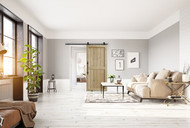A Guide to Interior Design Styles: Scandinavian
Oct 10th 2019
Scandinavian design may seem like a recent style taking over the design world, but it has a lengthy history dating back to the 1930s. The style arose during a time in which many facets of life were changing, but not everyone was content to let this harsh progress continue. Northern European designers in particular wanted to push back from industrialization and social inequalities to create something beautiful, unfussy and functional for all.
Scandinavian design later came onto the American stage in the 1950s with a touring design show called “Design in Scandinavia.” The show featured the best of this design, already several decades old at the time. Today, Scandinavian design style has continued to capture interest around the world for its love of natural, muted and minimalist-chic features.
All Things Bright and Airy
One of the most noticeable features of Scandinavian design is its apparent lack of color palette. Bright white is a major design element in this style, appearing on everything from the walls to the furniture and fabrics. Such a high proportion of white gives a natural brightness to the room, which certainly plays into its Scandinavian origins – where winters are often long and dark. Designing homes that feature a light-toned palette can bring a sense of calm, comfort and serenity to one’s life.
Of course, white isn’t the only shade you’ll see. Scandinavian design is known for its organic contrasts, where black & white certainly makes a regular appearance, but so do pairings of white and muted natural tones.
To give your room a Scandinavian look, try incorporating lighter shades of blue, sage green, charcoal, blush pink or warm tan. Remember to keep the selection simple. The Scandinavian design style isn’t about tons of colors across the design. Pick two to pair with white, and use them as accent pieces, such as a cozy throw blanket or a bedside lamp.
With that said, don’t be afraid to add a small yet unexpected pop of color somewhere in your plans, whether it’s a bright red vase or a bold blue wall clock. Scandinavian design is known for its little surprises.
Using Natural Materials
Along with bright white and pastel tones, Scandinavian design puts its focus on materials found in nature. Wood, of course, is the prime element for flooring, tables and chairs. Unlike other styles, like mid-century with its warm mid-tone wood and traditional with its dark, highly finished wood, Scandinavian style turns to stripped-down versions from trees like beech, white pine and ash.
Wood floors are left to reveal their natural beauty, instead of being covered with wall-to wall area rugs or carpeting. Harkening back to its origins, though, the style isn’t afraid to introduce textures from a faux fur rug or a thick knit hall runner.
To introduce Scandinavian style into your floor decor, try placing a geometric print natural fiber rug before your bed. You could also add a faux fur or faux sheepskin rug near the fireplace, or a homespun, tasseled jute rug in the kitchen or near the sofa.
Of course, wood and fiber aren’t the only natural materials making a name for themselves in this design style. Stone might appear as part of a table design, but it might be as simple as a grouping of river rocks nestled against an end table. Leather is another common material that often appears on sofas and chairs, but it is always weathered to fit in, not stand out.
Adding Textures
Softer colors are the hallmark of Scandinavian style, but so are carefully placed textures. What’s important to remember is that texture is used organically to create natural flow. You won’t find a medley of textures jutting up against one another, like you might with eclectic Bohemian design.
Instead, Scandinavian style textures could appear as a chunky knit blanket on the bed or a cozy throw blanket on the sofa. Scandinavian design textures are beautiful, but they’re also functional – a textured blanket adds visual appeal while keeping you warm.
Bringing Nature Inside
Since natural materials and organic design are so integral to Scandinavian design, it’s no surprise that plants and greenery play a major role as well. Not only do plants improve indoor air, but they add a natural pop of color within a minimalist framework.
Individual potted plants spaced around a room blend well with the design style’s sense of simplicity. If you try to add too many plants, you’ll run into a cluttered room – and you’ll end up moving away from the Scandinavian design style you’re after. And don’t worry about seeking out specific plants. The plant species matters far less than the way in which it’s placed around the room.
Simply Beautiful Barn Doors
There’s a lot to love about the laid-back, uncluttered beauty of Scandinavian design style. If you’ve incorporated the most common design features described above, why not complete the look with sliding barn doors? By replacing the interior doors around your home with gorgeous sliders from Barndoorz, you’ll add a functional, beautiful and space-saving design element – exactly what Scandinavian style is all about.
If you’re focused on the kitchen, you could use one of the Inglewood modern barn doors for the pantry door – perhaps with the Traditional Winter or Traditional Owl Gray finish. For a hall or living room closet, the Chevron MDF Two Piece barn door adds the ideal geometric design without appearing too flashy. The white tone will match those bright white Scandinavian walls while making a subtle statement with the chevron pattern.
Barndoorz is ready to transform your space into the perfect Scandinavian retreat. For personalized assistance, give us a call at 713-400-6626 or reach out on our website. We look forward to helping you find a barn door that brings Scandi-style right to your home. Contact us, we can help.
